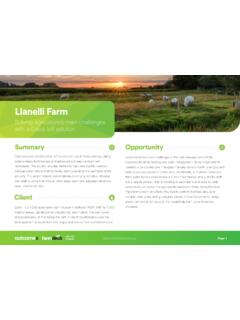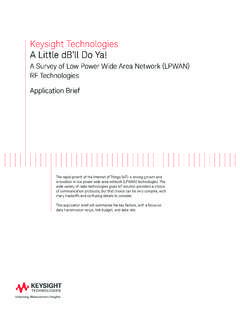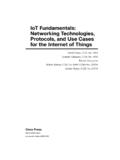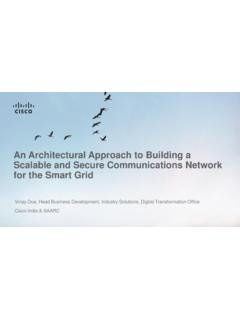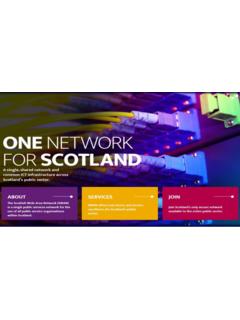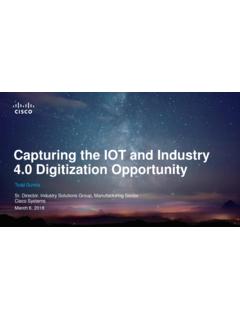Transcription of Integration of LoRaWAN and 4G/5G for the Industrial ...
1 IEEE Communications Magazine February 2018600163-6804/18/$ 2018 IeeeAbstrActCurrent forecasts predict that the Industri-al Internet of Things will account for about 10 billion devices by 2020. Simultaneously, unli-censed low-power wide area networks are gaining momentum due to their low cost, low power, and long range characteristics, which are suitable for many IIoT applications, in addition to the usage of unlicensed bands. In this article, a solution is proposed to seamlessly integrate LoRaWAN , an open and standardized LPWAN technolo-gy, with 4G/5G mobile networks, thus allowing mobile network operators to reutilize their cur-rent infrastructures. This proposal is transparent to LoRaWAN end devices and to the EPC, since only the LoRaWAN gateway needs to be modified. The gateway acts as an evolved Node B from the core network perspective, implementing part of the eNB protocol stack.
2 All data packets trans-ported over the core network are both encrypted and integrity protected, hence achieving end-to-end security. As a proof of concept, this solution has been implemented and validated with an open source Internet of Things (IoT) is one of the hot-test topics in communications today. Although the forecast of 50 billion devices by 2020 may be outdated, the general trend that early analysts predicted is undeniable. Current values vary from 6 to 9 billion devices, whereas forecasts estimate from 20 to 30 billion IoT devices for 2020 ( , Ericsson s figure is 28 billion for 2021) [1]. Gart-ner [2] has forecast that Industrial IoT (IIoT) devic-es will represent around 37 percent of the global number, which will account for about 57 percent of overall IoT spending in there is no formal definition [3], an IEEE report describes IoT as a network of items each embedded with sensors which are con-nected to the Internet.
3 Considering the type and the purpose of the things connected, IoT systems can be classified into consumer, Industrial , and manufacturing. Consumer IoT systems connect things that con-sumers utilize such as wearable devices, home automation, and security devices, or for health-care. Their purpose is to improve the users qual-ity of life. Industrial IoT systems connect things that basically are non-consumer ( , things used by professionals and companies). IIoT use cases encompass Industrial machinery, transportation monitoring, logistic tracking, asset tracking, health-care, intelligent buildings, smart cities, smart agri-culture, and smart metering. Their purpose is to increase productivity and reduce the environmen-tal impact. Manufacturing IoT systems are focused on factories in order to optimize their processes (smart manufacturing).
4 The precise industries that are covered under IIoT depend on the approach of the different industry bodies. For example, in many cases the terms Industrie and IIoT are used interchange-ably, but the former is restricted to However, the Industrial Internet2 Consortium considers the following industries as the major IIoT vertical markets: energy, healthcare, manufac-turing, smart cities, and of these IIoT use cases can be consid-ered as massive machine-type communications (mMTC), one of the three major fifth generation (5G) use cases (in addition to enhanced mobile broadband, and ultra-reliable and lowlatency MTC). For mMTC, there are two technologies that meet the low power and wide area require-ments of these applications: cellular evolution and low-power wide area networks (LPWANs). The Third Generation Partnership Project (3 GPP) efforts try to leverage existing mobile net-works for providing cellular IoT connectivity in order to avoid the maintenance and operation of a parallel network.
5 The cellular IoT standardiza-tion proposes complete Integration with mobile network operator (MNO) previous cellular standards have been used for MTC communications, they are not specifically suitable for mMTC services due to high cost and high power consumption. Specifi-cally, based on these standards, 3 GPP has defined the following schemes: Extended Coverage Glob-al System for Mobile Communications (EC-GSM), LTE Cat-0 (a new low-complexity Long Term Evo-lution user equipment, UE, category 0, defined in 3 GPP Release 12), LTE-M (also known as Cat-M1), and narrowband IoT (NB-IoT, also known as Cat-M2).The advantage of both LTE Cat0 and LTE-M is that they are compatible with existing LTE networks. NBIoT addresses the requirements of mMTC, but utilizes a different radio technology (DSSS modulation), so it requires a specific fre-quency band ( , using dedicated spectrum, refarming GSM channels, or utilizing some resource blocks within a normal LTE carrier).
6 Jorge Navarro-Ortiz, Sandra Sendra, Pablo Ameigeiras, and Juan M. Lopez-SolerADVANCED Industrial WIRELESS SENSOR NETWORKS AND INTELLIGENT IOTThe authors propose a solution to seamlessly integrate LoRaWAN , an open and standardized LPWAN technology, with 4G/5G mobile networks, thus allowing mobile net-work operators to reutilize their current infrastruc-tures. This proposal is transparent to LoRaWAN end devices and to the EPC, since only the LoRaWAN gateway needs to be authors are with the University of Object of LoRaWAN and 4G/5G for the Industrial Internet of Things1 Industrie is a term coined by the German Federal Gov-ernment to optimize indus-trial production and provide smart manufacturing solutions . 2 Industrial Internet is a term coined by General Electric (GE), one of the founding members of the Industrial Inter-net Consortium.
7 According to GE, the Industrial Internet of Things, also known as the Industrial Internet, is defined as an internet of things, machines, computers and people, enabling intelligent Industrial operations using advanced data analytics for transformational business out-comes. IEEE Communications Magazine February 201861 The first trials of these technologies started at the end of 2016, launching the first deploy-ments in try to cover the gap between tradi-tional cellular technologies and current mMTC requirements. Local and mesh networks can fulfill many requirements such as low battery consumption and optimization for low data transfers, but they cannot offer global area cov-erage. Examples of LPWAN technologies are LoRaWAN , SigFox, RPMA, and NWave. They offer long range (up to several tens of kilome-ters), very low power consumption (years of bat-tery operation), and very low bandwidth (tens of kilobits per second), and utilize license-exempt frequency LPWAN technologies have much lower cost compared to traditional cellular networks.
8 This fact allows new players to assume the role of network operators, thus competing with cur-rent MNOs. Studies such as [4] predict that LPWANs will generate revenues of US$23 billion by 2020, so MNOs will be highly motivated to regain the market. For this reason, many MNOs (KPN, Orange, SK Telecom, Bouygues Telecom, Swisscom, SoftBank, etc.) have started to deploy LoRaWAN networks to complement their current cellular this article, we devise a novel solution to seamlessly integrate LoRaWAN with the core net-work of a 4G/5G mobile network, that is, with an Evolved Packet Core (EPC). Our solution will allow MNOs to reutilize their existing infrastruc-tures with minimum investment, and to easily integrate this service into their operation and maintenance (O&M) platforms. Additionally, end-to-end security is ensured between the LoRaWAN devices and the application servers.
9 Although this work is focused on LoRaWAN , many of the ideas could be applied to other types of LPWAN. We selected LoRaWAN due to its excellent features, such as very low cost (for both end devices and infrastructure), very low power consumption, very long range, bidirectional communications, and high rest of the article is organized as follows. First, we present previous works. LoRaWAN is then described. Next, LoRaWAN and LTE security aspects are summarized, respectively. We explain our proposal for LoRaWAN and 4G/5G mobile networks Integration . As a proof of concept, the main issues of the developed prototype are pre-sented, and finally, we conclude the WorksTo the best of the authors knowledge, there are no other proposals to integrate LoRaWAN (or other unlicensed LPWAN technologies) with 3 GPP mobile , other solutions to integrate Wi-Fi into LTE have been proposed.
10 The purpose of this Integration is different from our proposal since the usage of Wi-Fi is intended to offload traffic, increasing the data rates, reducing the interfer-ence on the cellular network, and saving on costs. Wi-Fi is particularly interesting to MNOs since, according to the latest cisco global mobile data forecast, 63 percent of the total mobile data traf-fic was offloaded through Wi-Fi or small cells in this purpose, 3 GPP has defined two WLAN interworking features in Release 13: LTE-WLAN aggregation (LWA) and LTE WLAN radio-level Integration with IPsec tunnel (LWIP). LWA aggregates LTE and WLAN at the radio access network (RAN) level by allowing WLAN access points to only interact with the LTE evolved Node B (eNB), that is, without interaction with the EPC. This approach eliminates the need for WLAN-specific core network nodes.

